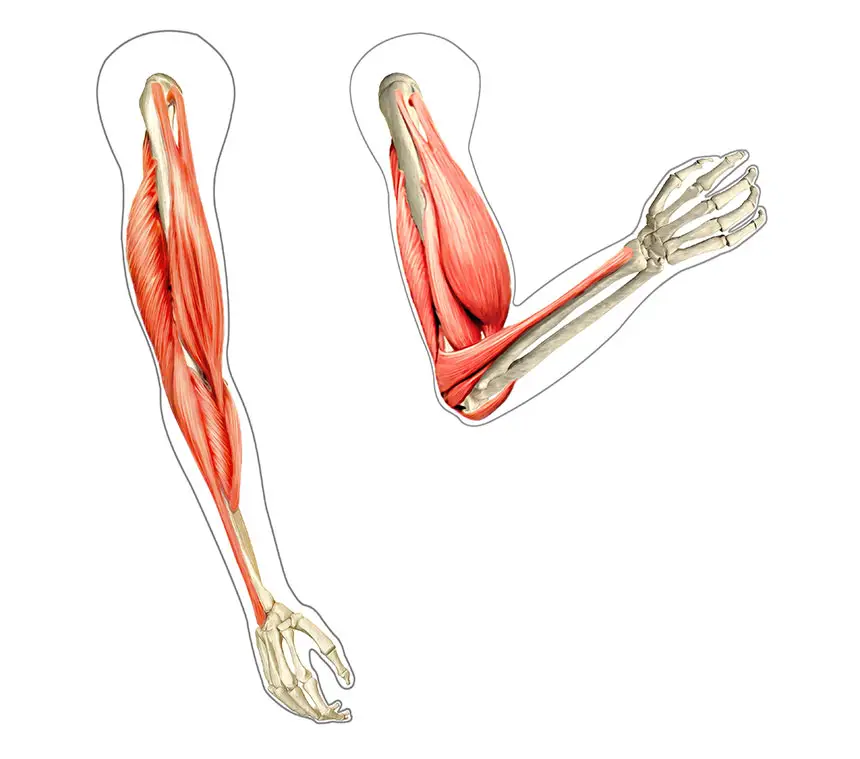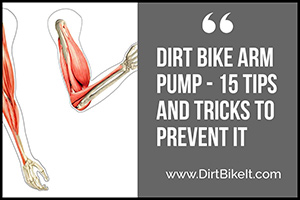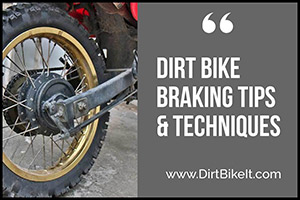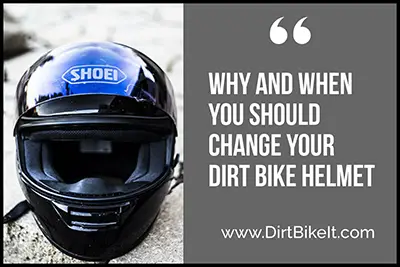Dirt Bike Arm Pump – 15 Tips and Tricks to Prevent It

Dirt Bike Arm Pump – 15 Tips and Tricks to Prevent It
Arm pump, oh no – the nightmare of every motocross rider but can you avoid it? There are physical injuries that can be expected while in pursuit of adventure and adrenaline rush in extreme sports. While such sports involve spectacular stunts, they also require a high level of physical exertion, which increases the risk and severity of injuries to the upper limbs and sometimes to the entire body.
Dirt biking is a good example of an extreme sport that not only exposes the body to twists, turns, jumps, bumps, but also to G-forces than that can have potentially damaging effects on the brain and bone structure of the racer.
Even when practicing safe riding techniques such as wearing full-body protective gear, your whole body is still vulnerable when dirt bike racing and injuries are bound to happen. One such common injury is the dirt bike arm pump, also known as Chronic Exertional Compartment Syndrome (CECS) in technical terms.
This condition affects motocross racers that mainly use their grip, which leaves it susceptible to injuries associated with high horsepower bikes and rough riding conditions.
What is a Dirt Bike Arm Pump?
An arm pump injury occurs along the forearm due to a pooling of blood that creates pressure. It’s this build-up of pressure that negatively affects the mechanics of the muscles and therefore, makes it impossible even debilitatingly painful for a rider to control the throttle, brakes, clutch and affects his or her ability to hold onto the bike. While arm pump isn’t life-threatening and usually doesn’t cause lasting damage if you get appropriate treatment certain factors such as a racers age, repetitive impact activities as well as overtraining can increase the risk of developing this condition.
How an Arm Pump Feels?
You would think that it would be great to be in a career that gives you rock hard forearms. However, this condition has been responsible for countless race track crashes because it causes a racers arms to feel like a concrete block, making it impossible for them to pull the brake or clutch lever.
The rest as you can imagine goes downhill quickly because if your ability to hold on to the grips and most importantly shut the throttle off is compromised in any way, no amount of protective gear can prepare you for what comes next.
Muscles Used in Motocross
The core muscles, which provide support for the whole body are the most important to concentrate on because inadequate strength on the obliques, abdominal muscles, hip flexors and spinal erectors will make it challenging for a rider to maintain a good riding posture and prevent lower back injury.
Additionally, having strong arms and shoulder muscles as well sufficient wrist and hand strength is important because they enable a rider to be in control of the bike while performing cringe-worthy and sometimes emergency maneuvers and stunts at high speed and over challenging terrain.
Signs of Dirt Bike Arm Pump
Due to the physical demands of riding that place enormous stress on a rider’s fingers, hands, wrists, and forearms, the obvious and most common symptoms to be expected with Chronic Exertional Compartment Syndrome will include but not limited to the following:
- A momentary tightness, tingling, numbness or weakness of the hand or arm
- An arm pain that starts within minutes of riding and then goes away 10 or 20 minutes or so afterward
- Forearm muscle swelling as a result of strenuous exertion or herniation
Causes of Arm Pump
Arm pump is sometimes confused with less serious injuries such as tendonitis, which makes it hard to diagnose even miss it in entirety. Being used to extreme sporting activities may cause an athlete to exercise through the pain as a coping mechanism. However, this has been shown to exasperate the condition, lessen recovery time after exercise over time and even lead to permanent muscle or nerve damage – which is every extreme sports enthusiast worst nightmare.
Arm pump is brought on by the blood’s inability to leave your forearm as it normally should, which often leads to a back-pressure build-up that compresses nerves and muscles and consequently causes a loss of elasticity to the forearm compartment. The inability to fully contract your muscles can happen to anyone, however, because every extreme rider is susceptible to arm pump at one point in their career, the condition can be prevented with a few of the following remedies:
-
Warm up Before a Race
The importance of a good warm-up before any workout, let alone before a race cannot be overstated enough. Not only does performing pre and post workout exercises play an important role in prepping the body for activity, even a five to ten-minute warm-up has been shown to be the most effective ways to help athletes maximize their athletic performance and aid in post-workout muscle recovery.
Warming up increases oxygen delivery to muscle tissue and aids in the removal of carbon dioxide, which is a harmful toxin especially when it comes to muscle performance.
A regular warm up before a race will also raise your core temperature for optimal flexibility, which will, in turn, lessens stress on the joint and tendons while riding. It also increases your heart rate to not only minimize stress on your cardiovascular system but to also allow in an increase of adrenaline, an important hormone that helps with a healthy heart rate and blood flow throughout your body.
The immediate impact of an adrenaline surge will lead to various responses in your body, such as an increase of glucose production that you need for energy. Adrenaline also heightens our fight-or-flight response to situations that are high-stress, dangerous or physically exhilarating – an important adaptation mechanism that is beneficial to extreme sports athletes that allows them to better cope with various situations during their performances.
-
Performing Regular Supplementary Workouts
When done in combination with regular endurance sessions, supplementary training such as HIIT workouts, mobility exercises, cross and strength training will all contribute to your aerobic fitness without any additional pounding to your muscles and joints. Research shows that an upward of 75% of athletic injuries are the result of overuse, which applies to all endurance sports such as dirt biking.
High-intensity interval training workouts can improve athletic endurance and performance because not only are they generally short and hard bouts of exercises but they also include periods of recovery in between.
Mobility exercises, on the other hand, promote efficient and economical movements in workouts and are beneficial for racers who are required to have adequate mobility through a particular range of motion without any major hindrances.
Building strength by following a regular strength training routine will also reinforce your risk of developing injuries, such as those caused by muscular imbalances during dirt biking performances.
-
Staying Hydrated
Electrolytes such as sodium, calcium, and potassium play a critical role in allowing cells to generate energy and they move water and fluids within the body to improve muscle contractions and a host of other activities from the lung, brain and heart. Keeping electrolyte concentrations within the normal limits involves stimulating the thirst mechanism when the body gets dehydrated.
Proper hydration, during training and race days for dirt bike riders, will prevent a sodium imbalance that can cause cells to malfunction during a race and lead to confusion, weakness or lathery. Hydration will also ensure that calcium levels are controlled and keep hypocalcemia-related symptoms such as weakness, muscle spasms, and heart rhythm disturbance at bay during races.
Hydration also ensures that riders do not experience the most common symptom of dehydration, which is cramping due to a lack of electrolyte and exasperated by excessive water loss from sweating. While there isn’t much an athlete can do in terms of how much sweat they lose during races, however, regardless of the temperature and activity levels, it is recommended to drink between 16 to 20 Oz of water to replenish the water lost during training and to keep the body’s electrolytes balanced.
Also, avoiding coffee, sugar, including a few well-known energy drinks that have dehydrating ingredients on race day will go a long way to minimize your risks of experiencing dehydration-induced arm pump.
-
Nutrition
Arm pump is mainly caused by a backup of blood coming from the heart into the forearms. A heart-healthy diet that includes fresh fruits and vegetables, 100% whole grains, healthy oils, low-fat milk products, and healthy proteins will keep you and most importantly, your blood healthy.
Food such as turmeric, ginger, garlic, mackerel, salmon, avocados, and almonds or drinks like green tea, grape, cranberry, and pineapple juice have been shown to be natural blood thinners. On the other hand, while vitamin K-rich foods such as leafy greens, Brussel sprouts, cauliflower, eggs, and liver are great for bone health, this vitamin is stored in the body because it is fat-soluble and helps with blood coagulation.
Too much of VK may lead to various complications such as causing a further backup of blood to your forearms thus leading to arm pump.
-
Avoid a Sedentary Life
The human body is designed to be in constant motion so as to get our nervous systems fired up and we need to move our bones and muscles as frequently as possible to keep our body functioning at its optimal capacity. Being a sedentary athlete poses a lot of harmful health and physical risks, especially for someone who takes up a physically demanding sport such as dirt bike racing.
Aside from the obvious health-related risks of inactivity, such as weight gain, high blood pressure, and heart disease, athletes are also susceptible to loss of flexibility in the arms, hip flexors, and low back. A sedentary lifestyle is also bad news for an avid athlete because it can also lower their metabolism, which in essence means that your body’s ability to break down fat slows down significantly or shuts down.
Inadequate exercising may also lead to muscle weakness, atrophy, and poor grip strength, especially in athletes whose main aim is to boost their overall performance. Exercising even when your body is screaming for you not to will improve overall circulation and consequently keep your heart healthy consequently alleviate arm pump.
-
Find the Right Bike
It’s recommended that in order to enjoy your riding experience, looking for a bike that is compatible with your height, for starters, will ensure that you don’t experience pain and discomfort on your legs, back, neck, wrists, and forearms.
-
Get Regular Riding Lessons
Whether you are a professional or a novice at dirt biking, it’s important to have all your maneuvers on point in order to minimize your risks of suffering from arm pump. Getting a few pointers from a skillful riding coach on a few and important bike handling skills will ensure that you are always in control of your motorcycle.
After all, the best way to react to any given situation during racing is through anticipating what’s ahead of you and knowing how you and your bike are going to respond. Launching a 200-plus pound bike and then coming back down unscathed calls for courage, a whole lot of arm and leg strength as well as proper body position, which takes years of practice. Therefore, in addition to learning from your favorite pro-riders, getting a few coaching lessons will go a long way in terms of perfecting your skills and as you get better, your risks of suffering from arm pump will decrease significantly.
-
Ride More Often
The best way to prevent arm pump is to improve your overall physical performance, including your bike handling skills by making it a habit of riding as often as you can.
-
Adopt the Standing Position
How you position your body when riding a dirt bike will determine how well you soak-up hits from rough terrains. It’s recommended that you place more weight on your legs than your arms by adopting the standing position, which granted can be challenging, but it’s the easiest way to not only prevent losing control of the bike, but this position will also take the pressure off your forearms and consequently mitigate arm pump.
Also, it’s very common to see beginners keeping a death grip on the bars or straighten their arms while riding a dirt bike. Doing this not only restricts blood flow to the forearms, but it’s during this process that you are starving your extremities of oxygen and will consequently lead to arm pump.
Additionally, the more relaxed you are, the easier it will be for you to be in control of your bike and you may also avoid crashing and injuring yourself and fellow riders.
-
Adequate Rest and Sleep
Dirt bike racing is one of the most physically and mentally exhausting sport there is. It requires you to be at your best in regards to your muscle tone and strength, which also includes being in a good head space in order to prepare yourself for the pressures of a race track not to mention the physical agility needed to maneuver and handle a heavy piece of machinery with finesse.
A lot of things are working against you while riding and physical and mental exhaustion is to be expected after the beating your body receives. Therefore, in addition to a nutritious diet, you need to get some much-needed rest both before and after a race not only as part of your recovery plan, but also to reduce your chances of suffering from arm pump and to prepare your body for future training.
-
Massage
A good head-to-toe body massage is one of the most effective ways to relieve delayed onset muscle soreness (DOMS) that occurs after you overloaded the muscles during your quest to get fitter and stronger. Nothing relaxes a sore body after a rigorous activity such as dirt bike riding like a good massage. It not only improves blood flow and reduces muscle tightness, but it also reduces the production of cytokines in the body, which play a critical role in inflammation and stimulates mitochondria cells that are vital for energy production and essential for cell function and repair.
-
Bike Maintenance
This may seem like a no-brainer, but it’s one aspect that’s often overlooked by many dirt bike beginners. Perform routine maintenance after every ride will not only keep your dirt bike running at its potential, but a finely tuned bike is less likely to cause accidents and goes a long way to ensure its safety and longevity.
Cleaning and lubing the most important controls of your bike such as the throttle and clutch, chains and sprockets as well as the suspension will not only protect them from wear and tear but will also ensure that your machine is equipped to handle both your weight and skill level.
-
Wearing the Appropriate Protective Gear for Motorcycle Riders
The key words here being “protective gear for motorcycle riders.” While wearing protective gear may not prevent the obvious bruising you may get from the impact of taking a tumble while riding, taking preventative steps of wearing safety gear including proper clothing, helmet, and protective padding is arguably the most effective ways that can help you keep severe injuries at arm’s length.
Your dirt bike clothing should have adequate padding that will ensure the safety of your entire torso. The gloves should be lightweight, provide an excellent grip of your bike, and most importantly, allow for a great amount of flexibility in your hand and fingers to ensure that you can safely hit the brakes and the clutch too and prevent you from slipping off as well.
Adequate padding is your body’s first line of defense for any impact that it sustains. An ideal setup should include knee and elbow pads, knee braces, and a chest protector too. You should also invest in a pair of goggles to protect your eyes from the dirt and debris while riding.
-
Stay Focused
It’s very easy to get distracted or lose focus while on a dirt bike trail. Keeping your head in the game is essential not only for your safety and those around you, but having the ability to concentrate by adopting certain pre-ride techniques will ensure that you are fully in tune with your bike, which will also help you anticipate various surprises on the track. You will also stay engaged and perfect your clutch, shift or braking skills, prevent injury and have fun while at it.
-
Arm Pump Remedies
Exposure to vibration, suspension shock, wrist extension from turning the throttle will inflame tendons in the palms and eventually cause a variety of forearm issues including arm pump syndrome. Early intervention methods include:
- Applying at least 5-minutes of cold therapy to your sore arms after riding to reduce inflammation and soft tissue damage
- Investing in quality muscle warm-up & therapy creams such as Real Time, Topricin FIBRO, Penetrex, as well as 4Arm Spray, or Biofreeze cold gel that deliver fast muscle relief, reduce stiffness and lactic acid build-up
- Taking arm pump supplements that are specifically designed to stimulate muscle protein synthesis, reduce lactic build, speed up muscle recovery, and increase strength and performance
- Additionally, using a self-therapy device known as the 4arm strong to apply pressure to key muscle groups on your forearm has been shown to be effective in stretching and training your forearm muscles to handle the strains of riding better as well as to reduce arm pump-related pain and discomfort incurred from repetitive motion
You can also mitigate arm pump by performing forearm workouts that will keep your blood flowing such as
- Biceps-and-triceps supersets
- Reverse barbell curls
- Triceps dumbbell kick-up
- Close-hands push-up
- Wrist curls etc.
Arm Pump Surgery
Maintaining adequate forearm strength and blood circulation is important if you want to avoid getting arm pump surgery. A fasciotomy may set you back between $1,000 to $6,000 without insurance and while it will improve the discomfort, it can be avoided altogether by increasing the facia elasticity through strength training exercises and performing forearm massages that promote blood flow.



